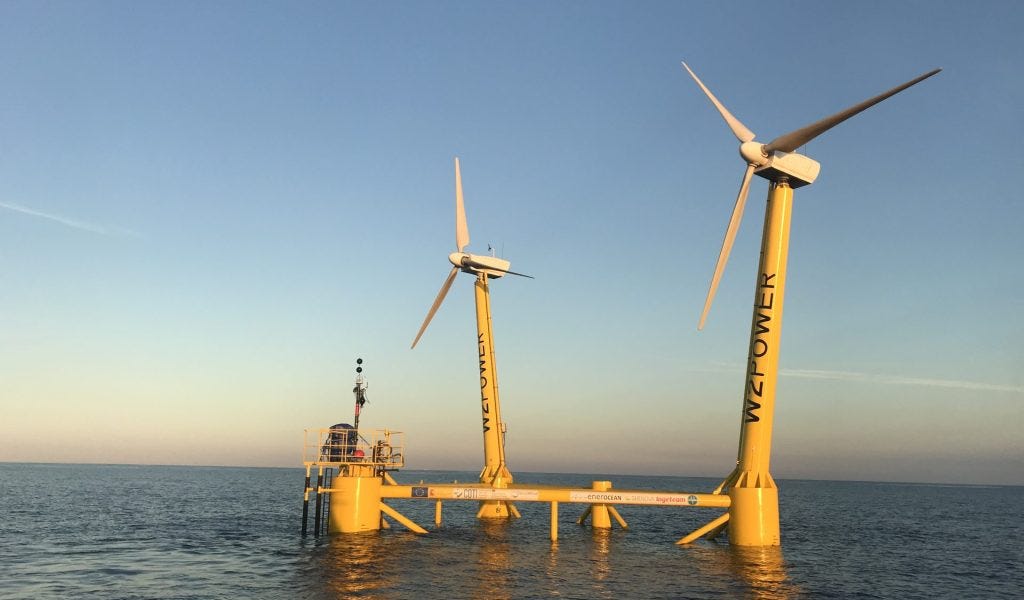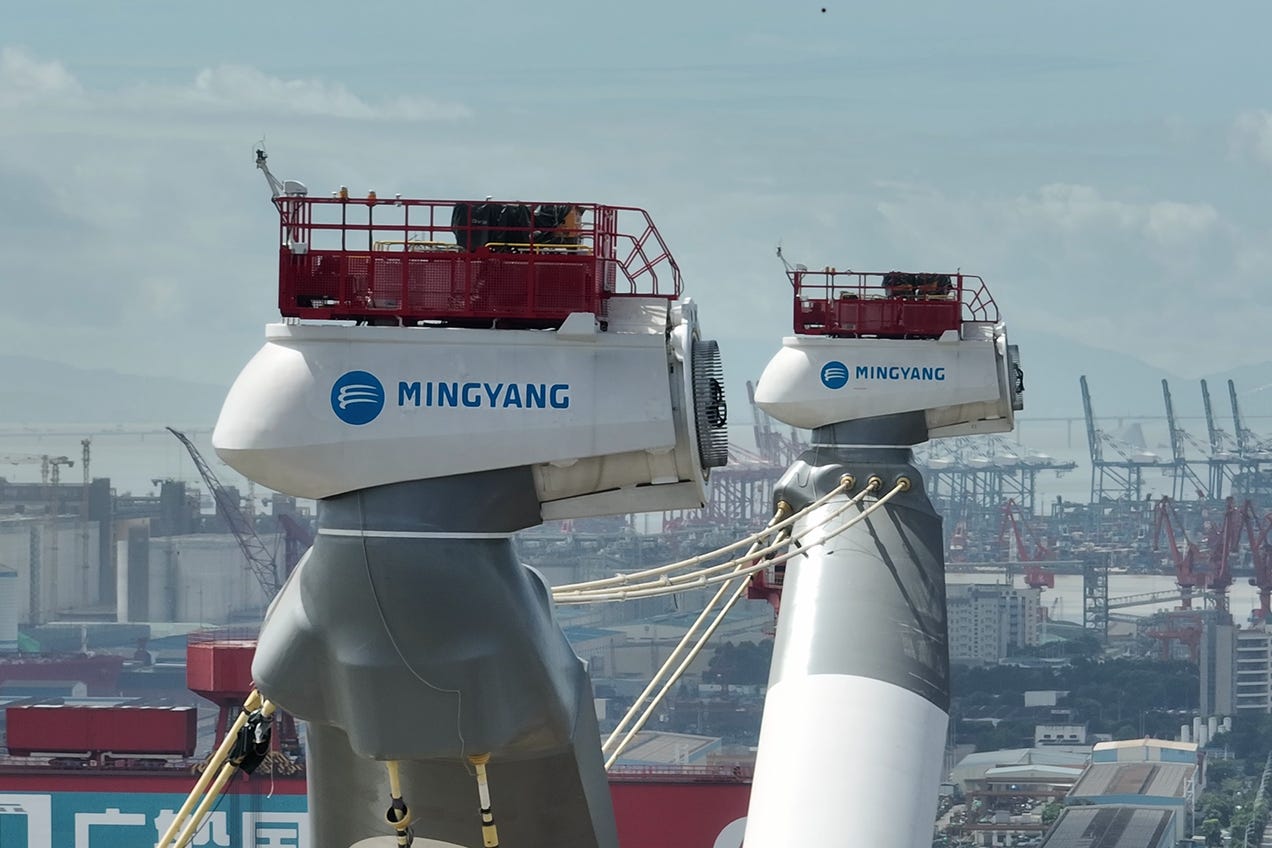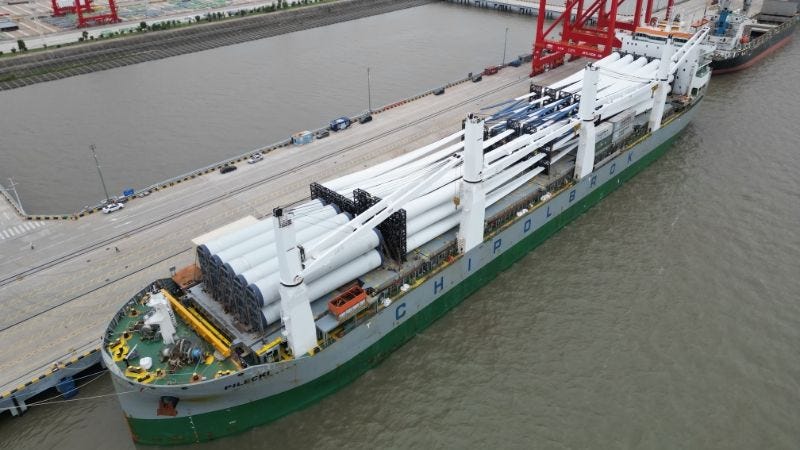Windletter #84 - The spectacular dual-rotor floating platform by Mingyang
Also: Iberdrola hybridizes Támega with 274 MW of wind power, Windey expands to Bolivia, the United States continues to attract investment in factories, and more.
Hello everyone and welcome to a new issue of Windletter. I'm Sergio Fernández Munguía (@Sergio_FerMun) and here we discuss the latest news in the wind power sector from a different perspective. If you enjoy the newsletter and are not subscribed, you can do so here.
Windletter is sponsored by:
🔹 Tetrace. Specialized services in operation and maintenance, engineering, supervision, inspection, technical assistance, and distribution of spare parts in the wind sector. More information here.
🔹 RenerCycle. Development and commercialization of solutions and specialized services in the circular economy for renewable energies, including comprehensive dismantling of wind farms and waste management, refurbishment and sale of components and wind turbines, management and recycling of blades and others. More information here.
Windletter está disponible en español aquí
The most read from the latest edition has been: the video of the SENSEWind prototype, the thoughts on the possible exit of Siemens Gamesa from India, the picture of the curious 180-meter hybrid tower in China. 📹.
That said, let's get to this week's news.
⚙️ The spectacular floating double-rotor platform by Mingyang
In the quest to make floating wind power a reliable, competitive, and mainstream technology, we are witnessing a true (and exciting) technological race.
A race in which different companies of all kinds propose and patent innovative solutions and transform them into spectacular prototypes that serve to test in real conditions the mistakes (and successes) made during their development. Floating laboratories from which to learn on the fly.
So far, most of these solutions involve designing different types of floaters that differ both in their physical form (barge, semi-submersible, spar, TLP…) and in the materials from which they are made (steel or concrete).
However, some players, in what is a riskier move, have bet on platforms capable of hosting two or more rotors on the same structure.
But what advantages do multi-rotor wind turbines have? Why is there so much movement around this type of design?
Well, on one hand, developing wind turbines with multiple rotors would allow for slowing down the growth in the size of turbines, at least regarding the nacelle, hub, and blades. Basically, installing 2 turbines of 8 MW or 4 turbines of 4 MW on the same structure instead of a single 16 MW turbine. Some even propose many units of 250 kW turbines.
This halt in size growth is an idea that has been floated in the industry for some time, and although it hasn't fully materialized (especially in the case of Chinese OEMs), signs of deceleration are already being detected.
Containing the size of the turbines would, in turn, allow for improving, optimizing, and making existing models more reliable, in addition to reducing costs through the industrialization of manufacturing processes (it is difficult to automate and optimize anything if every year you have to remodel the factory for a new and larger model).
Tests conducted so far in various projects also show signs of improvements in wake effects, increasing total generation in parks with many turbines.
The multi-rotor concept is something that has already been tested previously onshore. Many of you might recall the endearing prototype of four rotors that Vestas tested for 3 years at the Østerild Test Centre with promising results. Or the not-so-endearing double rotor prototype (on the same axis) by CSSC Haizhuang Wind Power. Additionally, CENER presented a simulation tool a year ago to support the development of this type of technology.
Regarding offshore, we have the case of the Spanish company EnerOcean, which tested its Wind2Power prototype at the PLOCAN facilities in the Canary Islands. We also have Hexicon and its TwinHub, which should install two prototype units of 2x8 MWs between 2025 and 2027.
And lastly (though I'm sure I'm missing some), we have Mingyang and its Nezzy² (designed by Aerodyn), a concept that already had a 1/10 scale prototype in Germany in 2020, and another one is currently being installed, this time at a commercial scale.
So, after all the predecessors, it will finally be the Chinese manufacturer Mingyang that is the first to test a design of this type and real size.
Windpowermonthly, through Eize de Vries, has gained exclusive access to pictures and data of this prototype named OceanX. The platform, with a total of 16.6 MW (2x8.3 MW), is currently in the assembly process to be later towed to its final location 700 kilometers away on the southeast coast of China. Specifically, at the Huangchuan shipyard, near Mingyang's headquarters in Zhongshan, Guangdong.
The 16.6 MW of power makes it the world's most powerful floating platform. An interesting fact is that Mingyang is the designer of both the platform and the turbine, which undoubtedly can lead to significant optimizations as the design is done holistically (rather than the turbine on one side and the floating platform on the other).
The truth is that the pictores are spectacular, although I'm not sure if they do justice to its true size. Just think that those blades measure 90 meters.
As you can see, the floater consists of three main elements: a long "leg" with a swivel mooring system and two shorter ones in a V-shape. Additionally, it has several steel stays that help the structure withstand the loads.
The turbines installed on the platform are two MySE 8.3-180 with Mingyang's super compact drivetrain. The following photo of the two nacelles is spectacular.
It is expected to reach Technology Readiness Level (TRL) 9, which would qualify it for full commercial application. Mingyang's initial market focus includes China and the Asia-Pacific region, with interest in Japan, South Korea, and the Philippines.
A video has also been shared on social media, showing the assembly process and giving a better sense of the platform's magnitude.
Pre-commissioning is expected to begin this July. We will be watching for future developments, so if you don't want to miss out, subscribe.
_
🌬️ Iberdrola will build the largest wind farm in Portugal to hybridize it with its Támega pumping station
Impressive project by Iberdrola in Portugal. The Bilbao-based company has obtained the Portuguese government's latest environmental approval to build the country's largest wind farm.
But what's particularly interesting about this wind farm, beyond its 274 MW capacity, is that it will be hybridized with the Támega pumping station. Both facilities will use the same grid connection point and share infrastructure such as the substation, which will be expanded.
Personally, I find this project very intriguing. It's a major hybridization effort that I wouldn't mind seeing the generation profiles and operational data for during its commercial operation, to understand how both technologies complement each other.
_
🌍 Windey sends blades to its Warnes II wind farm in Bolivia
Chinese manufacturers continue their international expansion efforts. If recently we discussed how Goldwind acquired a nacelle factory in Brazil, now we see Windey sending turbines to Bolivia for the Warnes II wind farm.
The project consists of 10 units of the WD156-4500 model, with a blade length of 75.8 meters and a power capacity of 4.5 MW each.
Windey itself celebrated on its LinkedIn account that this shipment marks the longest ever made by the company and will serve as a starting point for its expansion in South America.
_
🇺🇸 The United States continues to attract investment in manufacturing plants
The IRA continues to attract investment in manufacturing plants for the United States, which has become a priority market for Western OEMs.
Thus, Nordex has just announced the reopening of its manufacturing plant in Iowa, with the aim of supplying the local market and driving its growth strategy in the country.
The company will manufacture nacelles for the current N163 turbine and is also expected to introduce a product specifically tailored to the US market. If I were to speculate, I would guess a turbine from the so-called "high capacity factor" category, similar to the SG 4.4-164, V163-4.5, or GE 3.6-154.
The attraction to the U.S. market is such that even Goldwind Americas CEO Zuo Feng, in statements to Windpowermonthly, has opened the door to establishing a manufacturing footprint in the United States to avoid potential tariffs on imports from China.
_
🖋 Vestas receives an order for 577 MW in Australia for the second phase of the 1.3 GW Golden Plains wind project
In November 2022, Vestas received an order for 756 MW (122 x V162-6.2 MW EnVentus turbines) for the Golden Plains wind farm in Australia. The customer was TagEnergy, an Australian IPP, and the contract included EPC scope (as is customary in Australia).
Now, nearly two years later, Tag Energy has placed an additional order for 577 MW, also under EPC format, to build the second phase of the project with Vestas, adding another 93 V162-6.2 MW turbines.
In total, this amounts to 1.3 GW, making it Vestas' largest onshore wind farm project to date. These figures are typical of offshore projects, although they are still shy of the scale of the SunZia project in the United States.
The first phase is currently under construction, while the second phase is expected to commence in the first quarter of 2025.
An interesting aspect, and something I've noticed with several Australian wind farms, is that the wind farm (the first phase) has its own website with a wealth of information on permits, environmental impact, blueprints, noise, community impact... This demonstrates a commendable exercise in transparency.
_
🪂 The parachute drone you'll probably never use in a wind turbine
Every now and then, videos pop up on LinkedIn showcasing "outlandish" ideas for innovative products.
The other day, I came across one that left me quite pensive. It's about a backpack/drone capable of activating when a technician falls from the nacelle, preventing the fall and executing a soft landing.
Most intriguing of all, it seems there is at least one prototype... though it's likely just a model for trade shows.
And I wonder: How much would the backpack weigh? Can you work with it on? Is it safe to deploy the blades? Can a drone of that size support the weight of a human?
Let's start by ensuring we're securely anchored when we step out onto the nacelle's roof... the rest are just futuristic videos. 🌟
Thank you very much for reading Windletter and many thanks to Tetrace and RenerCycle, our main sponsors, for making it possible. If you liked it:
Give it a ❤️
Share it on WhatsApp with this link
And if you feel like it, recommend Windletter to help me grow 🚀
See you next time!
Disclaimer: The opinions presented in Windletter are mine and do not necessarily reflect the views of my employer.










